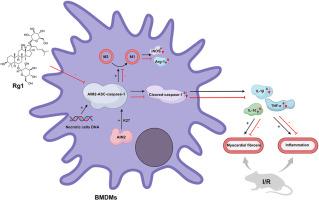人参皂苷 Rg1 通过抑制巨噬细胞极化减轻心肌缺血再灌注损伤的心脏炎症反应
IF 6.8
2区 医学
Q1 CHEMISTRY, MEDICINAL
引用次数: 0
摘要
背景心肌缺血/再灌注(MI/R)损伤是全球死亡的主要原因,对心脏健康构成重大威胁。人参皂苷 Rg1 对炎症激活、氧化应激和心脏损伤有抑制作用,这表明 Rg1 可能对心肌缺血再灌注损伤有治疗作用。材料和方法用 Sprague-Dawley 大鼠进行冠状动脉左前降支结扎,在体内构建 MI/R 模型。我们使用器官指数、心电图、梗塞大小、组织病理学变化以及心脏损伤和炎症因子检测来评估心肌炎、巨噬细胞极化和纤维化。我们还利用大鼠骨髓衍生巨噬细胞(BMDMs)进一步研究了 Rg1 对体外黑色素瘤 2(AIM2)活化和巨噬细胞极化的影响。Rg1 能明显减轻心肌梗死/再损伤过程中的心肌炎症反应并抑制 M1 巨噬细胞极化。此外,Rg1 还能明显减轻心肌梗死/再损伤时的心脏纤维化。这种抗纤维化作用可能有助于缺血损伤后心脏结构和功能的保护。同时,Rg1 在体外有效抑制了 AIM2 炎性体的激活,突出了其作为炎症通路关键调节因子的潜力。 结论我们的研究结果阐明了 Rg1 心脏保护作用的多方面机制,包括其缓解炎症、调节巨噬细胞极化和抑制纤维化的能力。本文章由计算机程序翻译,如有差异,请以英文原文为准。

Ginsenoside Rg1 reduces cardiac inflammation against myocardial ischemia/reperfusion injury by inhibiting macrophage polarization
Background
Myocardial ischemia/reperfusion (MI/R) injury is the main cause of death worldwide and poses a significant threat to cardiac health. Ginsenoside Rg1 has been shown to have inhibitory effects on inflammatory activation, oxidative stress, and cardiac injury, suggesting that Rg1 may have therapeutic effects on MI/R injury. However, the mechanism remains to be further studied.
Materials and methods
Left anterior descending coronary artery ligation was performed in Sprague-Dawley rats to construct an MI/R model in vivo. Organ index, electrocardiogram, infarct size, histopathological changes, and detection of cardiac injury and inflammatory factors in the rats were used to evaluate myocarditis, macrophage polarization, and fibrosis. We also used rat bone marrow-derived macrophages (BMDMs) to further investigate the effects of Rg1 on absent in melanoma 2 (AIM2) activation and macrophage polarization in vitro.
Results
Administration of Rg1 exhibited dose-dependent cardioprotective effects and effectively reduced MI/R injury. Rg1 significantly attenuated myocardial inflammation and inhibited M1 macrophage polarization during MI/R injury. Furthermore, Rg1 significantly reduced cardiac fibrosis in response to MI/R injury. This anti-fibrotic effect may contribute to the preservation of cardiac structure and function following an ischemic insult. Meanwhile, Rg1 effectively inhibited the activation of the AIM2 inflammasome in vitro, highlighting its potential as a key regulator of inflammatory pathways.
Conclusion
Our findings elucidate the multifaceted mechanisms underlying Rg1's cardioprotective effects, including its ability to mitigate inflammation, modulate macrophage polarization, and inhibit fibrosis.
求助全文
通过发布文献求助,成功后即可免费获取论文全文。
去求助
来源期刊

Journal of Ginseng Research
CHEMISTRY, MEDICINAL-INTEGRATIVE & COMPLEMENTARY MEDICINE
CiteScore
11.40
自引率
9.50%
发文量
111
审稿时长
6-12 weeks
期刊介绍:
Journal of Ginseng Research (JGR) is an official, open access journal of the Korean Society of Ginseng and is the only international journal publishing scholarly reports on ginseng research in the world. The journal is a bimonthly peer-reviewed publication featuring high-quality studies related to basic, pre-clinical, and clinical researches on ginseng to reflect recent progresses in ginseng research.
JGR publishes papers, either experimental or theoretical, that advance our understanding of ginseng science, including plant sciences, biology, chemistry, pharmacology, toxicology, pharmacokinetics, veterinary medicine, biochemistry, manufacture, and clinical study of ginseng since 1976. It also includes the new paradigm of integrative research, covering alternative medicinal approaches. Article types considered for publication include review articles, original research articles, and brief reports.
JGR helps researchers to understand mechanisms for traditional efficacy of ginseng and to put their clinical evidence together. It provides balanced information on basic science and clinical applications to researchers, manufacturers, practitioners, teachers, scholars, and medical doctors.
 求助内容:
求助内容: 应助结果提醒方式:
应助结果提醒方式:


